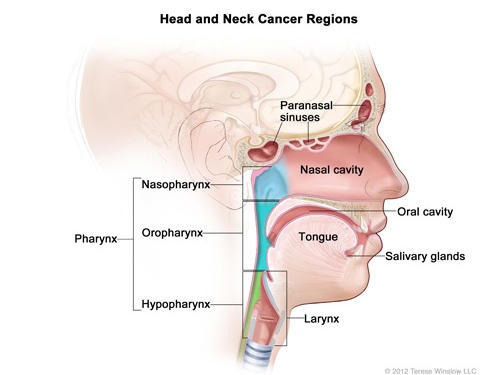Head and Neck cancers
Overview
Head and neck cancers refer to a group of malignancies that develop in the oral cavity, pharynx, larynx, nasal cavity, paranasal sinuses, or salivary glands. These cancers are particularly significant in India, where lifestyle and environmental factors contribute to a higher incidence compared to many other regions of the world.
Causes and Risk Factors
The majority of head and neck cancers arise due to long-term exposure to certain risk factors, including:
Tobacco use: Smoking and chewing tobacco are the leading causes.
Alcohol consumption: Heavy alcohol use acts synergistically with tobacco.
Human papillomavirus (HPV): Especially linked to oropharyngeal cancers.
Poor oral hygiene and chronic irritation (e.g., from ill-fitting dentures).
Occupational exposures: Wood dust, paint fumes, and certain chemicals.
Dietary deficiencies and genetic predisposition also play contributory roles.
Common Subsites
Head and neck cancers can occur in several anatomical subsites, such as:
Oral cavity – lips, tongue, gums, floor of mouth, buccal mucosa.
Oropharynx – tonsils, base of tongue, soft palate.
Larynx – voice box (glottic, supraglottic, subglottic regions).
Hypopharynx – lower part of the throat.
Nasal cavity and paranasal sinuses.
Salivary glands.
Common Symptoms
Symptoms vary depending on the site but often include:
Non-healing ulcers or sores in the mouth.
Persistent sore throat or hoarseness of voice.
Difficulty in swallowing or pain while swallowing.
Lumps in the neck.
Unexplained weight loss or bleeding from the mouth/nose.
Early detection dramatically improves outcomes, making awareness and timely medical consultation crucial.
Treatment Approaches
Treatment depends on the site, stage, and patient factors. It typically involves a combination of:
Surgery – for tumor removal while preserving function and appearance.
Radiation therapy – often used as a primary treatment or after surgery to eliminate microscopic disease.
Chemotherapy – combined with radiation (chemoradiation) for advanced cases.
Targeted therapy and immunotherapy – for select patients with recurrent or metastatic disease.
Cutting-Edge Cancer Care by Dr. Rajesh Natte
Dr. Rajesh Natte, a leading radiation oncologist, is at the forefront of treating head and neck cancers using state-of-the-art radiation technologies. By integrating image-guided radiotherapy (IGRT), intensity-modulated radiotherapy (IMRT), and stereotactic precision techniques, Dr. Natte ensures that tumors receive optimal radiation doses while sparing healthy tissues like the salivary glands and spinal cord.
With adaptive planning, AI-assisted contouring, and motion management systems, treatments are more precise, shorter, and better tolerated than ever before. His approach combines advanced technology with compassionate care — helping patients achieve excellent tumor control, reduced side effects, and improved quality of life.
Summary
Head and neck cancers, though challenging, are increasingly curable with early detection and advanced treatment. Modern radiation techniques, as expertly implemented by Dr. Rajesh Natte, have transformed outcomes — offering patients not just survival, but a path to recovery with dignity and function preserved.


